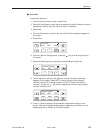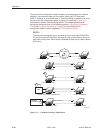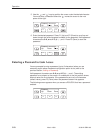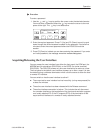
Operation
3-45
3160-A2-GB21-80
March 1999
6. From the Channel Config screen, select Clear.
F1
Channel Config:
Dsply Clear DTE
F2
F3
7. From the Clear Channel screen, select NET to clear all DS0 channels
assigned to the network interface. Or, select DTE to clear all DS0 channels
assigned to the DTE Drop/Insert (DSX-1) interface. Or, select a port to clear
all assignments for that data port.
F1
Clear Channel:
NET DTE Port1
F2
F3
Providing Backup Capability
If the T1 network fails, the DSU/CSU provides the ability to reconfigure the unit
and restore (at least partially) priority data circuits through an external backup
device.
You can store backup configuration options in the Customer 2 set of
customer-defined configuration options. The Enterprise MIB variable
devConfigAreaCopy allows the entire contents of one configuration area to be
copied into another configuration area via SNMP.
By cross-connecting two synchronous data ports to each other, one port can
provide a backup path for the other. As soon as the ports are configured to be
mapped to each other, Data Set Ready (DSR) for the ports is turned on. The
external backup device can be configured to initiate dialing when it detects the
off-to-on transition of DSR.
Selecting the Timing Source
The DSU/CSU provides the ability to select a master clock (timing) source that is
used to synchronize all of the T1 and data port interfaces on the DSU/CSU. The
clock for each interface is at the appropriate rate for that interface (e.g., 1.544
Mbps for the T1 interfaces, the configured port rate for the data ports), and it is
independent of the master clock rate. This means that the master clock rate and
the DSU/CSU interface rates may be different.


















